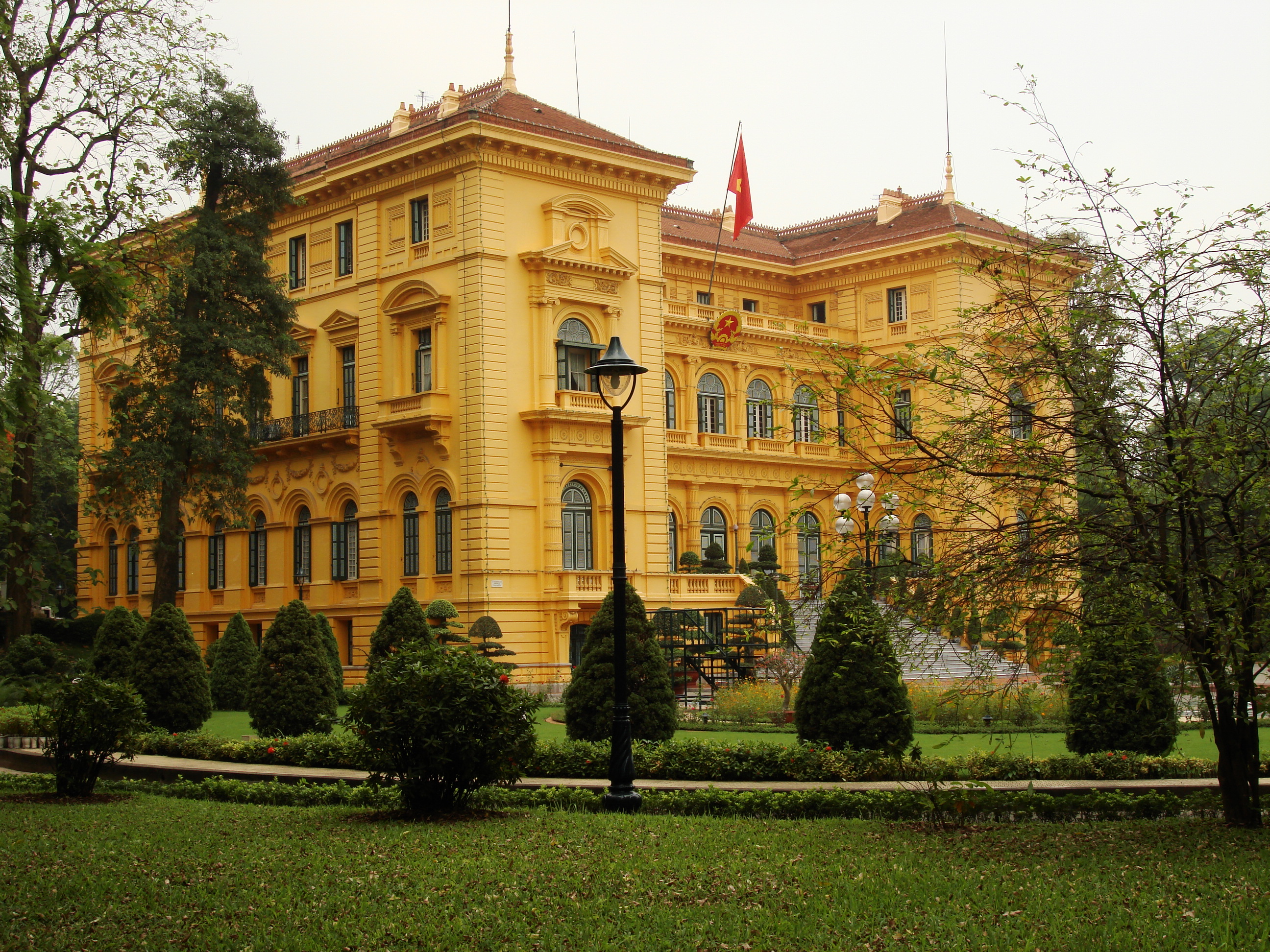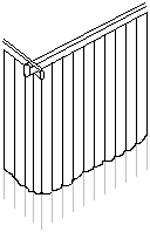|
Poteaux-en-terre
A post in ground construction, also called earthfast or hole-set posts, is a type of construction in which vertical, roof-bearing timbers, called posts, are in direct contact with the ground. They may be placed into excavated postholes, driven into the ground, or on sills which are set on the ground without a foundation. Earthfast construction is common from the Neolithic period to the present and is used worldwide. Post-in-the-ground construction is sometimes called an "impermanent" form, used for houses which are expected to last a decade or two before a better quality structure can be built. Post in ground construction can also include sill on grade, wood-lined cellars, and pit houses. Most pre-historic and medieval wooden dwellings worldwide were built post in ground. History This type of construction is often believed to be an intermediate form between a palisade construction and a stave construction. Because the postholes are easily detected in archaeological surveys, t ... [...More Info...] [...Related Items...] OR: [Wikipedia] [Google] [Baidu] |
Bousillage
Bousillage (bouzillage,McDermott, John Francis. "bousillage, bouzillage, n. m.". ''A Glossary of Mississippi Valley French, 1673-1850''. St. Louis: , 1941. 34. Print. bousille, bouzille) is a mixture of clay and grass or other fibrous substances used as the infill (chinking) between the timbers of a half-timbered building. This material was commonly used by 18th-century French colonial settlers in the historical New France region of the United States and is similar to the material Cob (material), cob and adobe. In French ''torchis'' has the same meaning or the meaning of a loaf of this material. Discussion ''Bousillage'' in south Louisiana is a mixture of clay earth and Retting, retted Spanish moss, but in the Upper Mississippi River Valley and Canada contains straw, grass or hair, used to fill in the panels in poteaux-sur-sol, poteaux-en-terre, and timber framing, half-timbered framing (called ''colombage'' in French). This was a technique used in French Louisiana by colonists from ... [...More Info...] [...Related Items...] OR: [Wikipedia] [Google] [Baidu] |
Pierrotage
Pierrotage is a half-timbered timber framing technique in which stone infill is used between posts. It was used in France and by French settlers in French Canada and Upper Louisiana."Pierrotage, pierotage" def. 1. Edwards, Jay Dearborn, and Nicolas Verton. ''A Creole lexicon architecture, landscape, people''. Baton Rouge: Louisiana State University Press, 2004. 155. Print. See also *Bousillage *French architecture *French colonization of the Americas *New France *Poteaux-en-terre *Poteaux-sur-solle *Ste. Genevieve, Missouri *Vernacular architecture Vernacular architecture is building done outside any academic tradition, and without professional guidance. This category encompasses a wide range and variety of building types, with differing methods of construction, from around the world, bo ... References Timber framing New France French colonial architecture French-Canadian culture in the United States French-American culture in Missouri Missouri culture Vernacular ... [...More Info...] [...Related Items...] OR: [Wikipedia] [Google] [Baidu] |
Timber Framing
Timber framing (german: Holzfachwerk) and "post-and-beam" construction are traditional methods of building with heavy timbers, creating structures using squared-off and carefully fitted and joined timbers with joints secured by large wooden pegs. If the structural frame of load-bearing timber is left exposed on the exterior of the building it may be referred to as half-timbered, and in many cases the infill between timbers will be used for decorative effect. The country most known for this kind of architecture is Germany, where timber-framed houses are spread all over the country. The method comes from working directly from logs and trees rather than pre-cut dimensional lumber. Hewing this with broadaxes, adzes, and draw knives and using hand-powered braces and augers (brace and bit) and other woodworking tools, artisans or framers could gradually assemble a building. Since this building method has been used for thousands of years in many parts of the world, many styles ... [...More Info...] [...Related Items...] OR: [Wikipedia] [Google] [Baidu] |
Poteaux-sur-sol
Poteaux-sur-sol ("posts on a sill" – sol is also spelled sole and solle) is a style of timber framing in which relatively closely spaced posts rest on a timber sill. Poteaux-en-terre and pieux-en-terre are similar, but the closely spaced posts extend into the ground rather than resting on a sill on a foundation, and therefore are a type of post in ground construction. Poteaux-sur-sol is similar to the framing style known in the United Kingdom as close studding. Poteaux-sur-sol has also, confusingly, been used for other types of timber framing which have a sill timber such as post-and-plank, but this is considered incorrect by some scholars. Poteaux-sur-sol is a part of American historic carpentry but is known by its French name in North America, as it was used by French and French-Canadian people in the region historically known as New France. Besides its appearance in French colonial architecture, it was also used in the 19th century by Ukrainian peasants living on the ope ... [...More Info...] [...Related Items...] OR: [Wikipedia] [Google] [Baidu] |
French Colonial Architecture
French colonial architecture includes several styles of architecture used by the French during colonization. Many former French colonies, especially those in Southeast Asia, have previously been reluctant to promote their colonial architecture as an asset for tourism; however, in recent times, the new generation of local authorities has somewhat "embraced" the architecture and has begun to advertise it. French Colonial architecture has a long history, beginning in North America in 1604 and being most active in the Western Hemisphere (Caribbean, Guiana, Canada, Louisiana) until the 19th century, when the French turned their attention more to Africa, Asia, and the Pacific. In Canada French settlements in Canada date back to the mid-16th century until the French defeat in Seven Years' War where New France was annexed by the British Crown in 1763 as a result of the Treaty of Paris. The settlements in the regions were extensive, hence the abundant architectural legacy from that per ... [...More Info...] [...Related Items...] OR: [Wikipedia] [Google] [Baidu] |
Missouri Culture
Missouri is a state in the Midwestern region of the United States. Ranking 21st in land area, it is bordered by eight states (tied for the most with Tennessee): Iowa to the north, Illinois, Kentucky and Tennessee to the east, Arkansas to the south and Oklahoma, Kansas and Nebraska to the west. In the south are the Ozarks, a forested highland, providing timber, minerals, and recreation. The Missouri River, after which the state is named, flows through the center into the Mississippi River, which makes up the eastern border. With more than six million residents, it is the 19th-most populous state of the country. The largest urban areas are St. Louis, Kansas City, Springfield and Columbia; the capital is Jefferson City. Humans have inhabited what is now Missouri for at least 12,000 years. The Mississippian culture, which emerged at least in the ninth century, built cities and mounds before declining in the 14th century. When European explorers arrived in the 17th century, t ... [...More Info...] [...Related Items...] OR: [Wikipedia] [Google] [Baidu] |
French-Canadian Culture In The United States
French Canadians (referred to as Canadiens mainly before the twentieth century; french: Canadiens français, ; feminine form: , ), or Franco-Canadians (french: Franco-Canadiens), refers to either an ethnic group who trace their ancestry to French colonists who settled in Canada beginning in the 17th century or to French-speaking or Francophone Canadians of any ethnic origin. During the 17th century, French settlers originating mainly from the west and north of France settled Canada. It is from them that the French Canadian ethnicity was born. During the 17th to 18th centuries, French Canadians expanded across North America and colonized various regions, cities, and towns. As a result people of French Canadian descent can be found across North America. Between 1840 and 1930, many French Canadians immigrated to New England, an event known as the Grande Hémorragie. Etymology French Canadians get their name from ''Canada'', the most developed and densely populated region of Ne ... [...More Info...] [...Related Items...] OR: [Wikipedia] [Google] [Baidu] |
History Of Construction
The history of construction embraces many other fields, including structural engineering, civil engineering, city growth and population growth, which are relatives to branches of technology, science, history, and architecture. The fields permit allow both modern and ancient construction to be analyzed, as well as the structures, building materials, and tools used. Construction has evolved and undergone different trends over time, marked by a few key principles: durability of the materials used, increase in building height and span, the degree of control exercised over the interior environment, and finally, the energy available for the construction process. Chronological development Neolithic construction The Neolithic, also known as the New Stone Age, was a time period roughly from 9000 BC to 5000 BC named because it was the last period of the age before woodworking began. The tools available were made from natural materials, including bone, hide, stone, wood, grasses, animal fi ... [...More Info...] [...Related Items...] OR: [Wikipedia] [Google] [Baidu] |
Building Engineering
Architectural engineers apply and theoretical knowledge to the engineering design of buildings and building systems. The goal is to engineer high performance buildings that are sustainable, economically viable and ensure the safety health. Architectural engineering, also known as building engineering or architecture engineering, is an engineering discipline that deals with the technological aspects and multi-disciplinary. The responsibilities of an architectural engineer are designs, analyzing, and altering plans, or structures. They also assist team members with project objectives budgets and timelines. What it is required to be an architectural engineer is a bachelor's degree master's degree or/and professional engineering license and current knowledge of industry trends, technology, codes and regulation. From reduction of greenhouse gas emissions to the construction of resilient buildings, architectural engineers are at the forefront of addressing several major challenges of t ... [...More Info...] [...Related Items...] OR: [Wikipedia] [Google] [Baidu] |
Stilt House
Stilt houses (also called pile dwellings or lake dwellings) are houses raised on stilts (or piles) over the surface of the soil or a body of water. Stilt houses are built primarily as a protection against flooding; they also keep out vermin. The shady space under the house can be used for work or storage. Arctic Houses where permafrost is present, in the Arctic, are built on stilts to keep permafrost under them from melting. Permafrost can be up to 70% water. While frozen, it provides a stable foundation. However, if heat radiating from the bottom of a home melts the permafrost, the home goes out of level and starts sinking into the ground. Other means of keeping the permafrost from melting are available, but raising the home off the ground on stilts is one of the most effective ways. Indo-Pacific Raised rectangular houses are one of the cultural hallmarks of the Austronesian peoples and are found throughout the regions in Island Southeast Asia, Island Melanesia, Micrones ... [...More Info...] [...Related Items...] OR: [Wikipedia] [Google] [Baidu] |
Post Church
Post church (Norwegian: ''stolpekirke'') is a term for a church building which predates the stave churches and differ in that the corner posts do not reside on a sill but instead have posts dug into the earth. Posts are the vertical, roof-bearing timbers that were placed in the excavated post holes. Posts were often placed in trenches filled with stone, but were still susceptible to decay. This type of construction is often believed to be an intermediate form between a palisade construction and a stave construction. Because the holes for the posts are easily detected in archaeological surveys they can be differentiated from the other two, even if none of the original post churches have survived. There is some debate over whether one stave church, the one at Røldal in Hardanger, Norway is in fact a post church. During restoration work it was noted that the posts seemed to touch the ground but as the church had sunken into ground it was difficult to verify if it was indeed a pos ... [...More Info...] [...Related Items...] OR: [Wikipedia] [Google] [Baidu] |
.jpg)








